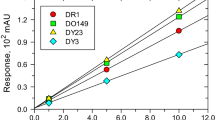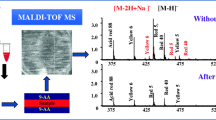Abstract
A highly sensitive procedure for the efficient routine control of aromatic amines derived from banned azo dyes in textile and leather products was developed and optimized. The procedure involves the extraction and reduction of azo dyes from solid samples following the sample preparation protocols outlined in EN 14362-1:2003, EN 14362-2:2003, and ISO/TS 17234:2003 standards, and cleanup and concentration of aromatic amines by solid-phase extraction, with Oasis HLB and ENVI-Carb sorbents in series. The elution was carried out with the cartridges connected in series, although the positions of the cartridges were reversed and the ENVI-Carb cartridge was placed in the backflush mode. Extracted and concentrated aromatic amines were separated and analyzed by liquid chromatography (LC)–tandem mass spectrometry (MS). The chromatographic separation was optimized by means of computer-assisted method development with a special chemometric tool (the PREGA LC-MS module), developed specifically for LC-MS systems. This system enables the unattended optimization of separations after a few priming isocratic and gradient experiments. The optimized separation program enables accurate detection and measurement of all the 23 aromatic amines considered, at very low quantification limits and without any notable matrix effects. Strategic sample composition was applied as an efficient means of reducing the costs and work involved in the control of aromatic amines in finished textile and leather products. The benefits of strategic sample composition are demonstrated by means of a case study of 20 sample specimens.


Similar content being viewed by others
References
Hildenbrand S, Schmahl FW, Wodarz R, Kimmel R, Dartsch PC (1999) Int Arch Occup Environ Health 72:M52–M56
Platzek T, Lang C, Grohmann G, Gi US, Baltes W (1999) Hum Exp Toxicol 18:552–559
Vineis P, Pirastu R (1997) Cancer Causes Control 8:346–355
Kalopissis G (1991) Mutat Res 246:45–66
Kalopissis G (1992) Mutat Res 269:9–26
de Perinat M (1997) Tecnología de la confección textil. Estudios Ediciones y Medios, Spain
Ahlström LH, Eskilsson CS, Björklund E (2005) Trends Anal Chem 24:49–56
Commission E (2002) Off J Eur Communities L 243:15–18
Second Amendment to the German Consumer Goods Ordinance (1994) Bundesgesetzblatt Part 1:1670
General Administration of Quality Supervision, Inspection and Quarantine of the People’s Republic of China (2003) GB 18401-2003. Chinese national general safety technical code for textile products
Rehorek A, Plum A (2006) Anal Bioanal Chem 384:1123–1128
Rehorek A, Plum A (2007) Anal Bioanal Chem 388:1653–1662
Straub R, Voyksne RD, Keever JT (1992) J Chromatogr A 627:173–186
Rafols C, Barceló D (1997) J Chromatogr A 777:177–192
Smyth WF, McClean S, O’Kane E, Banat I, McMullan G (1999) J Chromatogr A 854:259–274
Eskilsson CS, Davidsson R, Mathiasson L (2002) J Chromatogr A 955:215–227
Ahlstrom LH, Amon S, Mathiasson L (2005) J Sep Sci 28:2407–2412
Ahlstrom LH, Bjorklund E, Mathiasson L (2005) Anal Bioanal Chem 382:1320–1327
Garrigós MC, Reche F, Marín ML, Jiménez A (2002) J Chromatogr A 976:309–317
Voyksner RD, Straub R, Keever JT, Freeman HS, Hsu WN (1993) Environ Sci Technol 27:1665–1672
Planelles F, Verdu E, Campello D, Grane N, Santiago JM (1998) J Soc Leather Technol Chem 82:45–52
Pielesz A, Baranowska I, Rybak A, Wlochowicz A (2002) Ecotoxicol Environ Saf 53:42–47
Höner A, Schulz H, Henriks-Eckerman ML, Mathiasson L, Wegener JW, Winkeler HD (2000) Final report, development of a harmonized test method for the detection of certain aromatic amines in leather due to the use of azo dyes. European Commission, Brussels
European Commission (2001) AALARM project G6RD-CT-2001-00600620. http://www.euroleather.com/aalarm.htm. Accessed Aug 2009
EN 14362-1:2003: textiles. Methods for the determination of certain aromatic amines derived from azo colorants. Detection of the use of certain azo colorants accessible without extraction. AENOR, Spain
EN 14362-2:2003: textiles. Methods for the determination of certain aromatic amines derived from azo colorants. Detection of the use of certain azo colorants accessible by extracting the fibres. AENOR, Spain
ISO (2003) ISO/TS 17234:2003: leather -- chemical tests -- determination of certain azo colorants in dyed leathers. IULTCS/IUC 20. ISO, Geneva
Starink RJ (2009) Results of proficiency test AZO dyes, March 2009. Institute for Interlaboratory Studies, Spiijkenisse
García-Lavandeira J, Losada B, Martínez-Pontevedra JA, Lores M, Cela R (2008) J Chromatogr A 1208:116–125
Martínez E, Cela R, Carro AM, Cobas JC, Garcia B (2002) J Anal Atom Spectrom 17:1373–1380
Martínez E, Landín P, Carro AM, Llompart M, Cela R (2002) J Environ Monit 4:490–497
Martínez E, Pazos M, Carro AM, Llompart M, Cela R (2003) J AOAC Int 86:846–855
Quintana JB, Martínez E, Carro AM, Lorenzo RA, Cela R (2003) Int J Environ Anal Chem 83:269–284
Rodil R, Martínez E, Carro AM, Lorenzo RA, Cela R (2004) LCGC North Am 22:272–286
Carpinteiro J, Quintana JB, Martínez E, Rodríguez I, Carro AM, Lorenzo RA, Cela R (2004) Anal Chim Acta 524:63–71
Pensado L, Blanco E, Casais MC, Mejuto MC, Martínez E, Carro AM, Cela R (2004) J Chromatogr A 1056:121–130
Deb K (2001) Multi-objective optimization using evolutionary algorithms. Wiley, Chichester
Cela R, Martinez E, Carro AM (2001) Chemom Intell Lab Syst 57:75–92
Schoenmakers P (1986) Optimization of chromatographic selectivity a guide to method development. Elsevier, Amsterdam
Cela R, Martínez JA, González-Barreiro C, Lores M (2003) Chemom Intell Lab Sys 69:137–156
Acknowledgements
This research was supported by the Spanish Ministry of Science and Innovation and FEDER funds; project CTQ2009-08377. J.G.L. is indebted to the Spanish Ministry of Education for a doctoral grant.
Author information
Authors and Affiliations
Corresponding author
Rights and permissions
About this article
Cite this article
García-Lavandeira, J., Salgado-Petinal, C., Blanco, E. et al. A sensitive and efficient procedure for the high throughput determination of banned aromatic amines in textiles and leather products aided by advanced sample composition. Anal Bioanal Chem 397, 751–763 (2010). https://doi.org/10.1007/s00216-010-3574-2
Received:
Revised:
Accepted:
Published:
Issue Date:
DOI: https://doi.org/10.1007/s00216-010-3574-2




